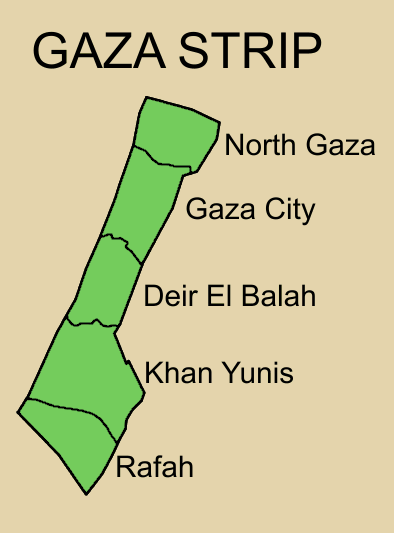TABLE OF CONTENTS:
- Introduction
- Layered internet shutdowns in Gaza
- Internet traffic in Gaza by ISP
- Summary of key findings
- Internet traffic in Gaza by location
- History of disruptions to telecommunications in Gaza
- Recommendations for action
- Glossary
Content note: The following post contains references to violence and war.
Since October 9, the 2.3 million residents of Gaza have been experiencing a devastating near-complete communications blackout, exacerbating their suffering as they endure heavy bombardment by Israeli forces and remain under complete siege with almost no water, food, fuel, or medicine. Fluctuating internet access and connectivity is contributing to uncertainty and fear, as people in Gaza are left without the ability to stay informed, keep connected with loved ones, access life-saving information, or document the human rights violations and atrocities occurring on the ground.
As of October 31, 15 of the 19 providers operating in Gaza were facing a complete shutdown of their mobile and broadband services, and the remaining four were each experiencing significant but varying levels of disruption, impacting millions of people. Complete shutdowns have directly affected an estimated 411,000 people using these providers in Gaza, as well as an additional 34,000 people in the West Bank.
The internet traffic across Gaza decreased by over 80% throughout October 2023. Outages across Gaza resulted from a combination of direct attacks on civilian telecommunications infrastructure, restrictions on access to electricity, and technical disruptions to telecommunications services.
This report provides a mapping of the main internet service providers (ISPs) in Gaza, with a case-by-case analysis of connectivity and changes in internet traffic for each ISP between October 4 and 31, 2023. Looking at the layered causes for internet shutdowns taking place – including ongoing partial disruptions resulting from infrastructure damage and more targeted intermittent disruptions appearing to have been deployed on a technical level – this analysis illustrates the extent to which people in Gaza are being forced offline.
LAYERED INTERNET SHUTDOWNS IN GAZA
Since October 9, connectivity throughout the Gaza Strip has been severely disrupted through a combination of shutdowns affecting many small and large ISPs. As we note above, overall internet traffic across Gaza decreased by over 80% in October. Entire governorates were offline between October 27 and 29, affecting networks previously spared from shutdowns, with immediate and devastating impacts. As of November 5, large-scale shutdowns continue to be imposed across Gaza.
Beginning on October 9, Israel’s bombing campaign targeted network installations and disabled two of the three primary mobile communication lines that connect Gaza to the outside world. Reports also suggested that the targeted airstrikes on telecommunications offices and infrastructure occurred the same day, effectively taking many ISPs offline.
Evidence indicates that the outages across Gaza resulted from a combination of direct attacks on civilian telecommunications infrastructure (including cell towers, fiber optic cables, and ISP offices), restrictions on access to electricity (through infrastructure attacks, denial of service, and blockading of fuel required to run generators), and technical disruptions to telecommunications services.
On October 27, as Israel prepared to launch a ground invasion into the Gaza Strip, unprecedented heavy bombardment severed the last remaining, already limited and intermittent, lines of communication, cutting the people of Gaza off from each other, emergency assistance, and the rest of the world. Palestinian telecommunications companies Jawwal and Paltel announced a complete shutdown of their internet and telecommunications services due to the destruction of their infrastructure.
The complete internet shutdown — which was gradually lifted after 36 hours — was premeditated. On October 23, the Israeli Ministry of Communications updated a press release acknowledging that plans were in motion for the “shutting down of cellular communications and internet services to Gaza,” and outlining extensive steps to ensure stable telecommunications in Israel, especially for settlements close to the border with Gaza. Following international pushback, Israeli authorities reverted to regional and partial shutdowns, especially in the northern part of Gaza, as the ground invasion began. On October 30, PalTel announced that its services were disrupted in the north due to heavy bombardment.
To determine the extent of the shutdowns that occurred from October 4-31 specifically, we conducted an in-depth analysis of internet traffic data for 19 of the largest ISPs operating in the Gaza Strip. It is important to note that while this report focuses on the period of October 4-31, disruptions to internet access and connectivity are still ongoing. On November 1, there was another complete internet and telecommunications shutdown, as Israeli authorities cut off internet and telecommunications services for around 8-9 hours overnight. Around 12:30 PM local time, PalTel reported that the internet was gradually restored, only for it to go down again an hour later. Similarly, on the night of November 5, Gaza experienced another internet disruption, beginning at 6:15 PM local time and lasting for over 15 hours. Internet service started to return on November 6 around 9:18 AM local time.
INTERNET TRAFFIC IN GAZA BY ISP
To fully document the extent of these internet shutdowns and their impact, we conducted an in-depth analysis of internet traffic data between October 4-31 for 19 ISPs that deliver the majority of mobile, landline, and wireless connections in the Gaza Strip. We identify each provider using their autonomous system number (ASN), and analyze data from multiple independent sources. Specifically, we draw from IODA, Cloudflare Radar, and RIPEstat, each of which has a unique set of data that come together to form a more full picture of each provider’s connectivity during the researched period. All resources are outlined in the methodology section below.
Among the 19 ISPs covered in this report, six ISPs (PalTel, DCC, SpeedClick, Mada, Fusion, and AjyalFi) each rely on a unique combination of Israeli and other foreign upstream providers to access the internet, as further detailed below. The remaining 13 ISPs are downstream customers of PalTel, DCC, and SpeedClick. The following illustration maps the up- and downstream relationships among these 19 ISPs operating in Gaza:
Note: A glossary of terms is provided at the end of the report. This glossary offers an explanation of technical terms and key terminology used throughout this report for our analysis of the outages in Gaza. If you can’t see the infographics below, please check your privacy-enhancing browser extensions. Open in desktop view for the best experience.
Map of ISPs included in this report (October 4-31, 2023):
Summary of key findings:
- As of October 31, 15 of the 19 analyzed providers were facing an ongoing complete shutdown of their mobile and broadband services, while the remaining four have all faced varied and fluctuating levels of disruption. As previously noted, complete shutdowns have directly affected an estimated 411,000 people using these providers in Gaza, as well as an additional 34,000 people in the West Bank.
- PalTel and its downstream providers, Hadara, Jawwal, and NetStream, account for at least 62.8% of the total market share across Palestine. Each of these four providers has coverage across the Gaza Strip and the West Bank. Following electricity cuts, lack of fuel, and bombings of ISP infrastructure, PalTel, Hadara, and Jawwal all experienced a series of disruptions and sustained drops of internet traffic in Gaza. In addition, as of October 31, NetStream was also experiencing a set of ongoing shutdowns.
- Mada, the second-largest telecommunications service provider in Palestine with an estimated 12.22% market share, was facing a series of intermittent and ongoing signal drops as of October 31.
- SpeedClick and its three downstream ISPs, JetNet, AlfaNet, and TechHub-HiNet, experienced an identical drop in traffic at 3:00 PM UTC on October 9. This shutdown was ongoing as of October 31.
- DCC and its two downstream ISPs, PalWiFi and CityNet, experienced a corresponding drop in traffic on October 9, at approximately the same time as SpeedClick, following the airstrikes on their facilities. This shutdown was ongoing as of October 31.
- Three other downstream providers of DCC, DCC Khan Younis, DCC North, and DCC Rafah, all experienced shutdowns beginning on October 8 or 9. These shutdowns were ongoing as of October 31.
- Fusion, which has two Israeli upstream providers, Cellcom and Coolnet, experienced a full shutdown from 1:00 PM UTC on October 12 that was ongoing as of October 31, affecting more than 96,000 people alone.
- AjyalFi, which has a main upstream provider from Israel, Bezeq, faced consecutive, large-scale traffic drops and as of October 31 had virtually no connectivity.
Following is documentation of the changes we observed in internet traffic across each of the 19 ISPs under study.
Overview
| ASN | Name | Upstream providers * | Area of service ** | Shutdown level | Shutdown duration |
| AS12975 | PalTel | Level 3 (American), Orange (French), Euroweb Romania (Romanian), Voxility (British) | Moderate disruption | Starting from October 7, ongoing as of October 31. | |
| AS15975 | Hadara | PalTel | Moderate disruption | Starting October 7, ongoing as of October 31. | |
| AS29310 | Jawwal | PalTel | Gaza Strip | Mild disruption | Starting from October 8, 11:00 AM UTC, ongoing as of October 31. |
| AS56995 | NetStream | PalTel | Full shutdown | Between October 12-13, and starting again from October 26, 8:30 PM UTC. Ongoing as of October 31. | |
| AS44213 | NewStarMax | PalTel (previously***: DCC, SpeedClick, AjyalFi) | Full shutdown | Between October 9, 3:00 PM UTC and October 19, 11:30 AM UTC. Then again between October 27-28 and October 30. Extremely limited connectivity as of October 31. | |
| AS203479 | Al-Aqsa | PalTel | Gaza | Full shutdown | Intermittent between Oct 14 and 31, ongoing as of October 31. |
| AS51407 | Mada | Level 3, Cogent (American), Tata (American), GTT (American), PCCW Global (American), Voxility (British), F5 Networks (French) | Moderate disruption | Starting from October 7 with intermittent disruptions, ongoing as of October 31. | |
| AS42314 | Fusion | Coolnet (Israeli), Cellcom (Israeli) | Khan Yunis, Gaza, Beit Lahia, Deir El Balah | Full shutdown | Between October 7, 11:00 AM UTC, and October 8, 3:00 PM UTC. Then again from October 9, 1:00 PM UTC, ongoing as of October 31. |
| AS210974 | AjyalFi | Bezeq (Israeli), (previously also: DCC) | Khan Yunis, Gaza | Full shutdown | Service was cut from October 7, 8:30 PM UTC and briefly restored. Full shutdown starting October 9, 2:00 PM UTC, with intermittent connectivity returning October 20. Other than a shutdown October 27-29, connectivity has returned in a limited capacity as of October 31. |
| AS57704 | SpeedClick | Cellcom, ITC NG (Israeli), Hot-Net (Israeli), PalTel (previously also: Bezeq, Lowhosting – Italian) | Khan Yunis, Gaza City | Full shutdown | Starting from October 9, 3:00 PM UTC. Ongoing as of October 31. |
| AS199046 | JetNet | SpeedClick | Khan Yunis, Gaza City, Bayt Lāhyā | Full shutdown | Starting from October 9, 3:00 PM UTC, ongoing as of October 31. |
| AS210116 | AlfaNet | SpeedClick | Khan Yunis | Full shutdown | Service was cut from 7:30 AM UTC on October 7 and briefly restored. Full shutdown starting October 9, 3:00 PM UTC, ongoing as of October 31. |
| AS213207 | TechHub-HiNet | SpeedClick (previously also: AjyalFi) | Rafah | Full shutdown | Starting from October 9, 3:00 PM UTC, ongoing as of October 31. |
| AS60268 | DCC | Bezeq (Israeli) (previously also: Cellcom) | Gaza, Khan Yunis | Full shutdown | Starting from October 9, 4:30 PM, UTC, ongoing as of October 31. |
| AS62027 | DCC Khan Younis | DCC | Khan Yunis | Full shutdown | Starting from October 9, 4:00 PM UTC, ongoing as of October 31. |
| AS203905 | DCC North | DCC | Full shutdown | Starting from October 8, 12:00 AM UTC, ongoing as of October 31. | |
| AS60353 | DCC Rafah | DCC | Rafah | Full shutdown | Starting from October 9, 6:00 PM UTC, ongoing as of October 31. |
| AS44075 | PalWiFi | DCC | Gaza, Khan Yunis | Full shutdown | Starting from October 9, 3:00 PM UTC, ongoing as of October 31. |
| AS56787 | CityNet | DCC (previously also: Cellcom) | Gaza, Khan Yunis | Full shutdown | Starting from October 9, 3:00 PM UTC, ongoing as of October 31. |
** The area of service is approximate based on the IP geo-location.
*** Within the studied duration (Oct 4-31), some ISPs relied on different upstream providers to route their traffic. The data is cross-referenced across three separate sources in the methodology section. “Previously” refers to upstream providers that appeared in the data sources historically.
PalTel
Hadara
Jawwal
NetStream
NewStarMax
Al-Aqsa
Mada
Fusion
AjyalFi
SpeedClick
JetNet
AlfaNet
TechHub-HiNet
DCC
DCC Khan Younis
DCC North
DCC Rafah
PalWiFi
CityNet
Data sources and methodology
- We examined internet traffic between October 4 to 31 using data from #KeepItOn coalition partners IODA and Cloudflare Radar. Information on how the traffic data is collected can be found here for IODA and here for Cloudflare.
- Additional data is extracted from RIPEstat. The data used for the AS Prefix Count is published in an 8-hour interval, at midnight UTC, 8:00 AM UTC, and 4:00 PM UTC.
- All times are listed in UTC+0 throughout the report. Local time in the Gaza Strip is UTC+3 until October 27. The observance of the Daylight Saving Time ended on October 28 at 2:00 AM local time, with local time then becoming UTC+2.
- Data on Palestinian ISPs and their market share and distribution between the Gaza Strip and West Bank was retrieved from Internet Society Pulse Internet Resilience Index and Country Reports.
- Data from APNIC Labs was used for population estimates for each ISP at the time of writing.
- Data on ASN relationships (provider/upstream and customer/downstream) in the Graph are retrieved from cross-referencing ASRank, RIPE Database, and Hurricane’s BGP Toolkit.
- Previous work by SMEX was also critical for this analysis.
INTERNET TRAFFIC IN GAZA BY LOCATION

The situation on the ground in the Gaza Strip is evolving quickly, with military movements correlating closely with increased disruptions to telecommunications. In one important snapshot, Cloudflare provided an analysis of drops in internet traffic by governorate according to data from Cloudflare Radar, comparing levels from October 15 to levels on October 1, prior to the escalation of the conflict beginning on October 7. Moving from north to south, Cloudflare found that, as of October 15:
- Gaza Governorate (the most populated area, in the north of the Strip, located just above Wadi Gaza river) was seeing around 60% less internet traffic. Daily traffic was down 56%.
- Deir al-Balah Governorate (located in the center of Gaza strip, below Wadi Gaza River) had around 80% less internet traffic. Daily traffic was down 70%.
- Khan Yunis Governorate had been impacted less, with less than 20% decrease in internet traffic.
- Rafah Governorate (near the Egypt border) was seeing 65% less internet traffic. Daily traffic was down 48%.
HISTORY OF DISRUPTIONS TO TELECOMMUNICATIONS IN GAZA
The current attacks on infrastructure in Gaza follow patterns from 2008, 2011, 2014, and 2021, during which the Israeli military repeatedly targeted vital civilian internet infrastructure or cut electricity and fuel supplies, leading to internet shutdowns and telecommunications disruptions. For instance, on May 12, 2021, Israeli military forces bombed the Al-Jawhara tower, impacting the telecommunications infrastructure housed in the building. Three days later, it toppled the Al-Jalaa tower, which houses the offices of some telecommunications providers and media organizations, including the Associated Press and Al Jazeera. The bombings taking place during the current conflict have damaged telecommunications infrastructure, causing full and partial shutdowns in the Gaza Strip. They have also led to electricity outages that further compromised connectivity.
The impact of the destruction or damage to telecommunications and internet infrastructure is exacerbated by the fact that Palestinians do not run their own independent ICT infrastructure. Under the Oslo Accords, Palestinians are granted “the right to build and operate separate and independent communication systems and infrastructures including telecommunication networks, a television network and a radio network.” However, no independent Palestinian ICT infrastructure has been allowed to develop since the agreement was signed in 1995.
Gaza’s only fiber optic cable that connects it to the global internet runs through Israel, making it infrastructurally dependent on Israel. Israeli authorities control the electromagnetic sphere and restrict Palestinian operators’ use of frequencies. They also maintain total control over importing essential equipment and technologies in the West Bank and Gaza. Due to the Israeli military blockade on Gaza since 2007, only material for civil use are allowed in, and any entry of equipment and construction materials must be approved by Israel’s Ministry of Defence. As a result, some necessary equipment has been denied entry under the allegation of “dual use” issues, and ISPs operating in Gaza cannot upgrade their services. To date, people in Gaza are still using 2G mobile networks. In the West Bank, 3G mobile networks were allowed for Palestinian companies in 2018, after 12 years of negotiations with Israel.
RECOMMENDATIONS FOR ACTION
Access Now, along with more than 140 civil society organizations and human rights experts, are calling for an immediate physical and digital ceasefire in the Gaza Strip, urging an immediate end to attacks against civilians and civilian infrastructure and the full restoration of telecommunications services in Gaza.
In particular, governments and internet service providers outside of Gaza, including in Egypt, should take urgent action to ensure connectivity is restored in Gaza, including by offering access to international e-SIM cards and facilitating reliable access to internet and telecommunications services.
Stakeholders across the international community should work together to put an end to internet shutdowns and telecommunications disruptions in Gaza, which violate international human rights law, including by enabling Palestinians to build, develop, and run their independent telecommunications infrastructure as stipulated under the Oslo Accords.
GLOSSARY
Following are brief definitions of the terms we use in this report that are relevant for understanding our technical analysis of the data on internet disruptions in Gaza:
- Our definitions for “full shutdown” versus “disruptions” based on percentage of traffic loss:
- None: 0% (No disruption)
- Mild: 1% – 20% (Minor disruptions affecting a small number of users or services)
- Moderate: 21% – 60% (Moderate disruptions affecting a moderate number of users or services)
- Severe: 61% – 85% (Major disruptions nearing a complete outage)
- Full shutdown: 85% – 100% (Complete outage affecting almost all users or services)
- Electromagnetic sphere: Sets of frequency bands used for cellular communications technology (3G, 4G, 5G).
- Upstream provider: An ISP with a larger network that contracts to provide access to the internet for downstream providers.
- BGP metric: The protocol networks use to communicate how to reach different IP address ranges. If a network stops announcing its prefixes, it might signal an outage or shutdown.
- Active probing metric: Involves sending “ping” requests to various networks. A lack of response from multiple networks within a region could indicate an outage or shutdown.
- Prefixes (public IPs ranges/blocks): Sequences of internet addresses allocated to a service provider for routing traffic online. Each prefix is a block of IP addresses under the entity’s management.
AS Prefix Count metric: A count of the IP address blocks that an Autonomous System reports. An AS comprises IP address ranges managed by a single entity, often an ISP. A drop in this count can imply potential accessibility issues within that AS’s portion of the internet.








